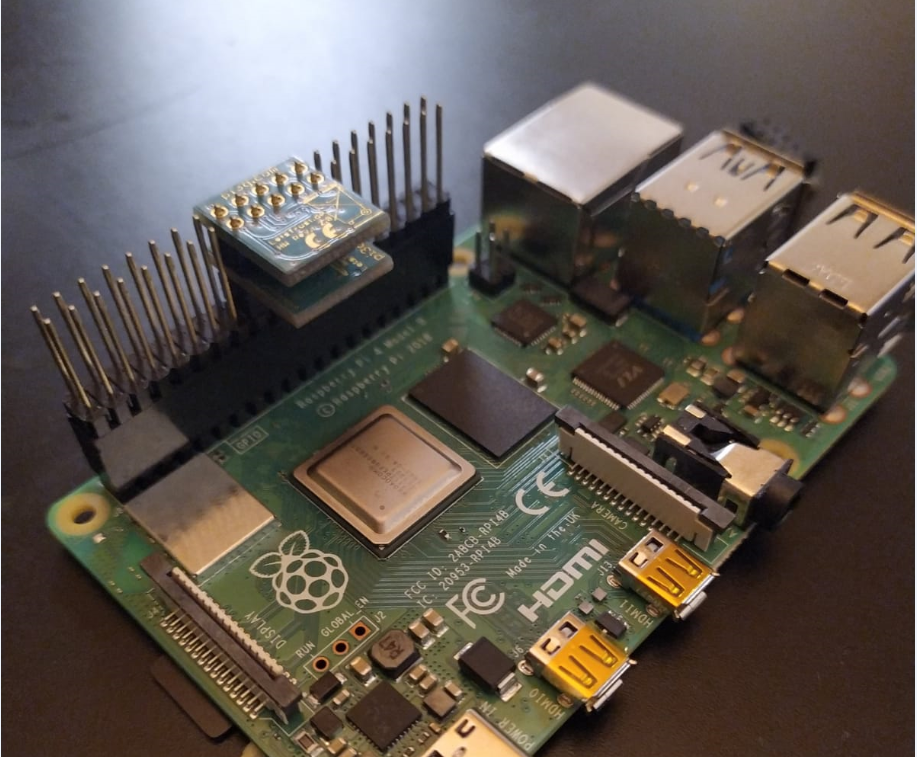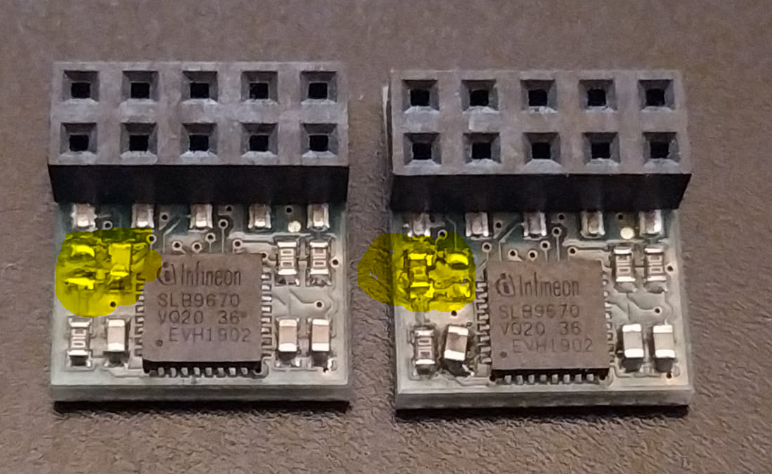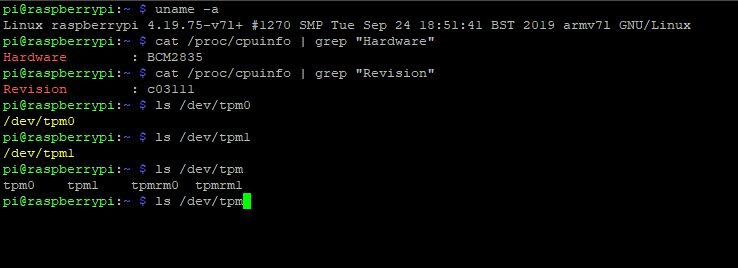Hello and welcome back!
Today I'm really happy and proud to introduce a new community around TPMs:
https://tpm.dev/
Tpm.dev was founded by Dimitar Tomov is a smart guy and he wants the same thing as I: Secure the world, a little more.
tpm.dev wants to be a platform:
To discuss security toppings. (mostly TPM related)
For help if you stuck on your project. (offside an old school mailing list)
Collect more useful stuff around TPMs and OpenSourceSoftware for that.
And between Lockdown there is a funny little meetup every wednesday over MS-Teams. Really interesting people are there (some of them are customers of LetsTrust-TPMs ^__^)
So feel free to join the community!
Bye for now!
Paul
Welcome back!
A few weeks ago Mr. M.P. write me an email with the question: May it possible to drive two TPMs on one Pi (4)?
Mr. M., want to drive one native TPM for the Pi and a second TPM as a remote vTPM for a client application.
So i've tested the Hardware Setting for Mr. M., after a few Minutes and combine this two posts:
1)
https://letstrust.de/archives/23-Move-LetsTrust-TPMs-to-CS0.html
2)
https://letstrust.de/archives/20-Mainline.html
Here the results:
Electrical- and mechanical-setting:
 Hardware configuration of the two TPMs:
Hardware configuration of the two TPMs:

and you'll need 2 TPMs, with one 0Ohm Resistor on position CS0. [1]
Linux log

I hope this will be helpful for you, too.
Bye for now!
Paul
[1]
References:
https://letstrust.de/archives/24-Hardware-update!.html
https://letstrust.de/uploads/letstrust-v2.2.placement.cs0.pdf
https://letstrust.de/uploads/letstrust-v2.2.placement.cs1.pdf
Hello and welcome back!
Today I'll introduce you to a new TPM project.
Pierre Fontaine combines a Raspberry Pi, Yocto and a TPM.
He invested a lot of time on his project and I'll appreciate his work with a blogpost here, here is a qoute from his website:
The Raspberry, Yocto Project and The TPM!
Overview
In the cybersecurity field we need to play with crypto primitives. It allows us to authenticate for services (ssh, vpn ...), encrypt files for confidentiality, sign mail for proving your identity to the recipient, and even securing the boot of a complex device ...
So you do need to store keys and use crypto algorithms such as RSA, ECDH, AES compliant with some criteria (industry, military, medical ...).
[1]
Thank you Pierre to share you knowledge!
Here is the Link:
Raspberry Pi, Yocto and a TPM
By for now!
Paul
[1] © Copyright 2019. Jerome Blanchard, Romain Brenaget and Pierre Fontaine
Welcome to the November of posts,
Today: Using a Trusted Platform Module for endpoint device security in AWS IoT Greengrass!
The credits goes to:
The Infineon guys for build an example for use a TPM and pkcs11 in an AWS IoT greengrass environment and share it on github[1].
And Krishnan Ganapathy from amazon web services writes a blog article about it[2].
Thanks for the great work!
Bye for now!
Paul
[1]
https://github.com/Infineon/amazon-greengrass-hsi-optiga-tpm
[2]
https://aws.amazon.com/de/blogs/iot/using-a-trusted-platform-module-for-endpoint-device-security-in-aws-iot-greengrass/
Welcome!
The last time i get some questions about the chipselect configs for the module.
How you could move the default config from the LT-TPM CS1 to CS0.
If you want to use the TPM with CS0 you must change (resolder) the position of the 0Ohm Resistor to the open pads.
You'll see the difference if you open both pdfs:
letstrust-v2.2.placement.cs1.pdf
letstrust-v2.2.placement.cs0.pdf
If you don’t want to compile your device-tree-overlay by yourself, copy the tpm-slb9670-cs0.dtbo [1] to /boot/overlays/ and load the dtbo in the /boot/config.txt
over the setting dtoverlay=tpm-slb9670-cs0
If you want to decompile change and recompile the devicetree for the slb9670 for yourself:
1) sudo apt-get install device-tree-compiler
2) dtc -I dtb -O dts -o /mnt/boot/overlays/tpm-slb9670.dts /mnt/boot/overlays/tpm-slb9670.dtbo
3) cp mnt/boot/overlays/tpm-slb9670.dts /mnt/boot/overlays/tpm-slb9670-cs0.dts
4) dtc -I dts -O dtb -o /mnt/boot/overlays/tpm-slb9670-cs0.dtbo /mnt/boot/overlays/tpm-slb9670-cs0.dts
[2][3]
Bye for now!
Paul
[1]
tpm-slb9670-cs0.dtbo
[2]
tpm-slb9670.dts
[3]
tpm-slb9670-cs0.dts
PS: this will only work on the Raspberry Pis 0-4
Hello!
I've updated the pcb-design,[1]
Now we have the revision 2.2!
Changes from rev 2.0 to rev 2.2 [2]
Add 100nF capacitor on the RESET line of the TPM for a better POR (Power On Reset) behavior..
Change pad 1 from octagon to square, for better identify pin 1.
Add tiny labels on every pin on the bottom side (without MISO/MOSI/CLK, no place for the labels on these pins)
I added a legend in the schematics, for better reference if you want to use the TPM on your own Hardware design.
Placement and the schematic you will find in the right column.
Bye for now
Paul
[1] two months ago
[2] Revision 2.1 was never produced.
Hello again,
in September this year I get mail from Luke Hinds, with some questions about the compatibility from LetsTrust-TPMs and RaspberryPis to check if will work for his project.
Now I proudly happy to link to this hilarious Project:
keylime.dev
Quote from Keylime.dev:
“Keylime is about making TPM technology accessible for developers and users. It handles the complexity, you drive the use case!”
Thanks to Luke and all contributors of Keylime!
Bye for now,
Paul
Welcome back!
no I´m not dead, \o/ ,
but the vulnerability ---TPM-fail--- need my highest attention today.
The good news: LetsTrust-TPMs are not affected!
But I'm not a friend of “hiding” information:
The SLB9670 that we used on our PCBs has the same certification levels on Common Criteria EAL4+ and FIPS 140-2 as the fTPM from Intel and the ST33 from STM.
If I get new information of the Chip on our LetsTrust-TPMs, I'll post an update here.
UPDATE: Quote from
http://tpm.fail/tpmfail.pdf
Our analysis reveals that Intel fTPM and the dedicated TPM
manufactured by STMicroelectronics leak information about
the secret nonce in elliptic curve signature schemes, which
can lead to efficient recovery of the private key. As discussed
in Section 6, we also observe non-constant-time behavior by
the TPM manufactured by Infineon which does not appear
to expose an exploitable vulnerability.
Bye for now
Paul
UPDATE: Reference:
tpm.fail
Reference:
zdnet.com
CVE-2019-11090 and impacts Intel's Platform Trust Technology (PTT).
CVE-2019-16863 and impacts the ST33 TPM chip made by STMicroelectronics.
Hello TPM friends,
after more than 18 months of work, compiling, testing, tears, blood...
MAINLINE! \o/
(On the RPi repository)
Now you find the dto in the newest raspbian image, per default.
To activate the TPM on your Raspberry Pi you need only these simple commands:
sudo apt-get update
sudo apt-get upgrade
sudo nano /boot/config.txt
sudo nano /boot/firmware/config.txt // for new RaspberryPi OS
// and activate SPI with uncomment
"dtparam=spi=on"
// and load the TPM device tree overlay with
"dtoverlay=tpm-slb9670"
// save the config.txt
sudo reboot now
// after the reboot
ls /dev/tpm*
// if you own a LetsTrust-TPM and plug it in the right way, you will get /dev/tpm0 and /dev/tpmrm0 in yellow letters
Thanks to all supportes

Bye for now!
Paul
Hello and Welcome!
I forgot these old post, the initial date in the database: 2017-05-10 01:00
Now, you may have fun with my old thoughts about the TPM market and the beginning of LetsTrust xD
(Expand to read the rest of this post)
"Background of these blog" vollständig lesen



